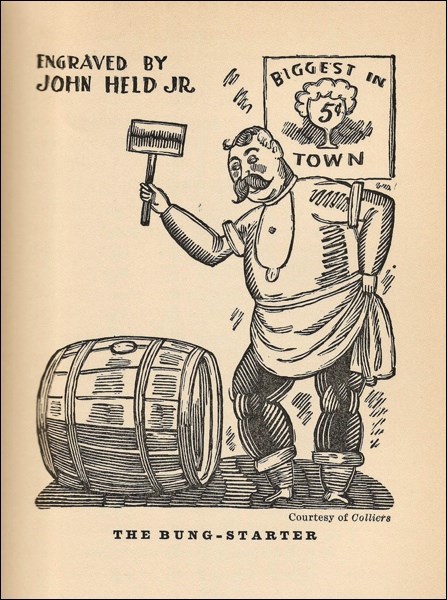How did small-town Saskatchewan hotels serve beer in the early 1900s? It started with the shipment of wooden beer barrels by train to the hotels, unloaded on railway station platforms. The Bulyea history book, Between Long Lake and Last Mountain (1982), shares a yarn about two local farmers who crawled under the train platform “armed with a brace and bit, a washtub, and several buckets.” When the hotel owner arrived to pick up his whiskey delivery, he was dismayed to find an empty barrel.
Because they had to stand up to pressure and liquid (and the occasional tampering), beer barrels were lined with pitch and made of thick, good quality wood. The barrel was filled by the brewery through a bung hole. Once filled, a plug was hammered into the hole, sealing the barrel.
Opening the beer barrel presented a challenge to many a hotel barkeep. They used what was called a “bung starter” – a heavy wooden mallet – to drive the wooden plug, bit by bit, up and out of the bung hole. Bill Graham, head bartender at the Great West Hotel in Davidson during the pre-1915 days, told the Star-Phoenix on June 1, 1948 that he opened many a keg of beer with a bung starter. Unless you were quick, Graham recalled, beer sprayed all over the place. “I got pretty good with that old bung starter,’ he said. “People would stand around and watch me with their mouths open.” The heavy bung starter also served as an excellent weapon for a beleaguered bartender.
During Prohibition, some hotel owners kept a barrel or two of beer hidden away in the basement of their establishments. On February 3, 1925, the Regina Leader-Post reported that police raided the Cecil Hotel in Moose Jaw. As the officers entered the hotel, they saw the man behind the bar pull a string. “The officers darted to the basement and attacked a locked cabinet, where they found a small keg overflowing with water driven into it at high pressure,” the paper stated. “There was, of course, a smell of beer about the place.” The hotel had installed a beer keg apparatus – allegedly invented to defeat liquor enforcement methods – consisting of a double spigot connected to the water main. The pulling of a string flooded the keg and removed the beer within seconds.
In 1935, when the Government of Saskatchewan permitted hotels to sell beer by the glass, Saskatchewan’s hotels scrambled to meet the government’s rigorous regulatory standards for licensing and reopen their beer parlours. In addition to building renovations and new furniture, hotels had to install new equipment for serving draft beer. “A 25-table beer parlour will require the most modern beer pumps, a cooling system, and cabinets,” the Leader-Post wrote on December 4, 1934. “It will need 100 chairs, at least 400 glasses and an insulated storage cellar.” Collectively, Saskatchewan hotels spent hundreds of thousands of dollars upgrading their bars. The Star-Phoenix reported on April 8, 1935 that Sterling Millwork Company and Cushing’s Limited had many orders for tabletops and refrigerators, and the John East Foundry was manufacturing $8,000 worth of table bases for hotels.
1935 was also a boom year for beer keg manufacturers. The Leader-Post reported on May 4 that one Regina brewery acquired 2,900 kegs for its new draft beer business. Of these, 800 were steel with an insulated aluminum lining. The remainder were wooden kegs “Handling of the empties by the breweries entails a lot of work,” the newspaper wrote. “They must be sterilized and repitched each time they go back to the brewery.”
Eventually, bottled beer became popular and draft beer sales declined. Today, draft beer is enjoying a comeback thanks to craft breweries.




